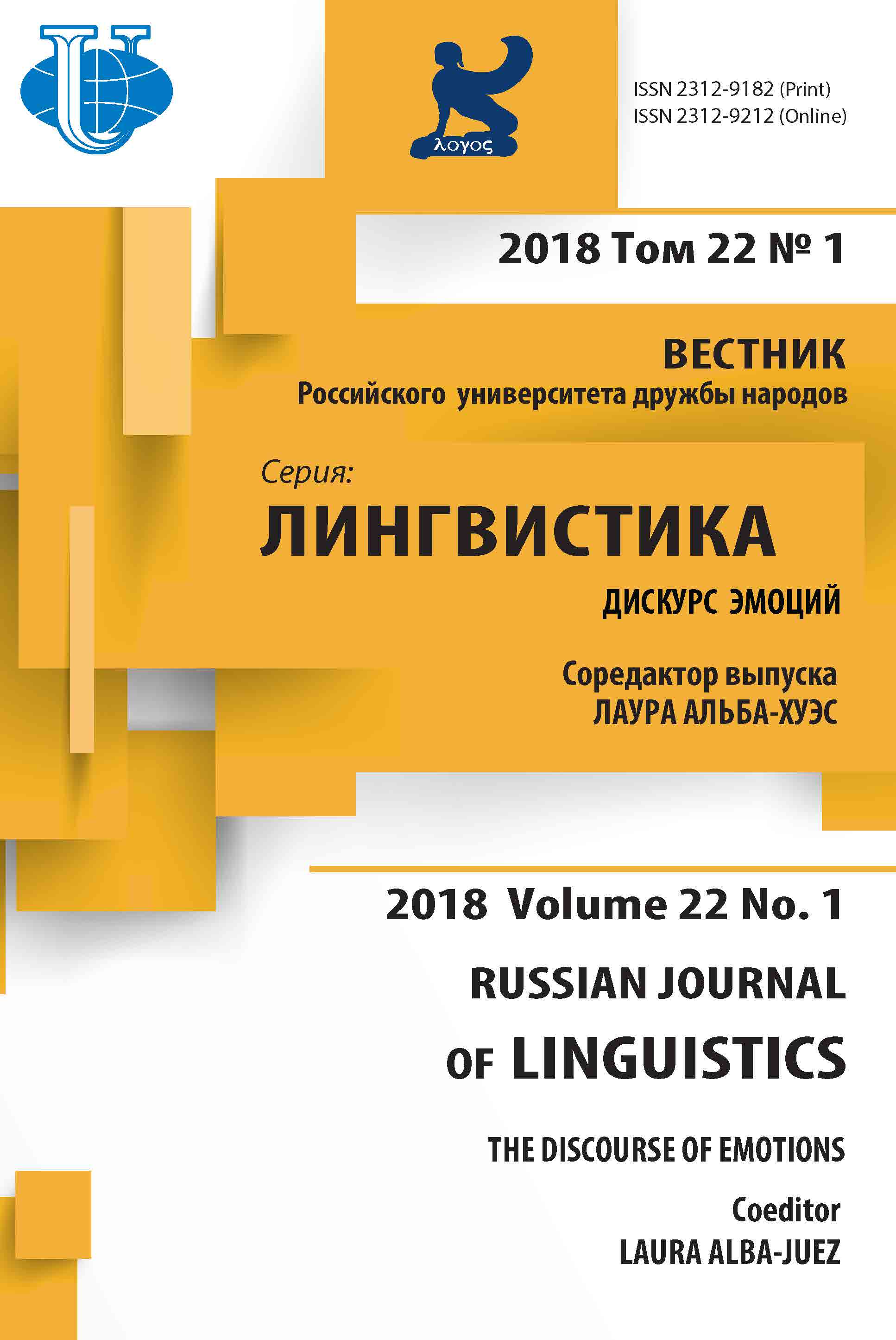SENTIMENT AND CONFIDENCE IN FINANCIAL ENGLISH: A CORPUS STUDY
- Authors: Mackenzie JL.1
-
Affiliations:
- Vrije Universiteit Amsterdam (VU University)
- Issue: Vol 22, No 1 (2018): The discourse of emotions
- Pages: 80-93
- Section: Articles
- URL: https://journals.rudn.ru/linguistics/article/view/17848
- DOI: https://doi.org/10.22363/2312-9182-2018-22-1-80-93
Cite item
Full Text
Abstract
In the financial world, the words sentiment and confidence are frequently employed to invoke the feelings of an individual investor or of investors in general about the future movement of a share or of the stock market in general. The article focuses on the use of the two words in financial journalism by examining all instances of sentiment and confidence in the on-line Hong Kong Financial Services Corpus and explores the hypothesis that they will differ from each other in line with how they are deployed in ordinary usage. Drawing inspiration from functionally-oriented semantics and Appraisal Theory, the core of the article reveals how the two words are employed in clauses and noun phrases in the corpus. Our findings reveal that sentiment and confidence are to a very large extent used in financial parlance as though they were synonymous. The use of these terms reflects the writers’ awareness of the role of emotions as a vital constituent factor in decision-making.
Keywords
About the authors
J Lachlan Mackenzie
Vrije Universiteit Amsterdam (VU University)
Email: lachlan_mackenzie@hotmail.com
J. LACHLAN MACKENZIE is Emeritus Professor of Functional Linguistics at VU Amsterdam. With a PhD from the University of Edinburgh (1978), his career was in the Netherlands, working closely with Simon Dik, Kees Hengeveld and many others on the development of Functional Grammar (FG) and Functional Discourse Grammar (FDG). He is currently associated with three research groups in Iberia: SCIMITAR (Santiago de Compostela), EMO-FUNDETT (Madrid) and CELGA-ILTEC (Coimbra).
References
- Ackert, L.F., Church, B.K., & Deaves, R. (2003). Emotion and financial markets. Federal Reserve Bank of Atlanta Economic Review, 2nd Quarter, 33-41.
- Alba-Juez, L. (Fc.) Emotion and appraisal processes in language: How are they related? In Gómez González, M.A. & J.L. Mackenzie (eds.; subm.), The Construction of Discourse as Verbal Interaction. Amsterdam: John Benjamins.
- Bednarek, M. (2008). Emotion talk across corpora. Houndsmills/New York: Palgrave Macmillan.
- Black, F. (1986). Noise. Journal of Finance, 41(3), 529-543. doi: 10.1111/j.1540-6261.1986.tb04513.x.
- Briesemeister, B.B., Kuchinke, L. & Jacobs, A.M. (2012). Emotional valence: A bipolar continuum or two independent dimensions? Sage Open, 2012 (2), 1-12. doi: 10.1177/2158244012466558.
- Charteris-Black, J. (2004). Corpus approaches to critical metaphor analysis. Houndsmills/New York: Palgrave Macmillan.
- Cheng, W. (2012). Exploring corpus linguistics: Language in action. London/New York: Routledge.
- Damasio, A.R. (1994). Descartes’ error: Emotion, reason, and the human brain. New York: Putnam.
- Fama, E.F. (1970). Efficient capital markets: A review of theory and empirical work. Journal of Finance, 25(2), 383-417. doi: 10.1111/j.1540-6261.1970.tb00518.x.
- Fama, E.F. (1991). Efficient capital markets: II. Journal of Finance, 46(5), 1575-1617. doi: 10.1111/j.1540-6261.1991.tb04636.x.
- Feldman, R. (2013). Techniques and applications for sentiment analysis. Communications of the ACM, 56(4), 82-89. doi: 10.1145/2436256.2436274.
- Foolen, A. (2012). The relevance of emotion for language and linguistics. In Foolen, A., U.M. Lüdtke, T.P. Racine & J. Zlatev (eds.), Moving Ourselves, Moving Others: Motion and Emotion in Intersubjectivity, Consciousness and Language. Amsterdam/Philadelphia: John Benjamins. 349-368. doi: 10.1075/ceb.6.13foo
- Frijda, N.H. (1986). The emotions. Cambridge: Cambridge University Press.
- Hey, J.D., & Morone, A. (2004). Do markets drive out lemmings - or vice versa? Economica, 71(284), 637-659.
- Kahneman, D., & Tversky, A. (1979). Prospect theory: An analysis of decision-making under risk. Econometrica, 47(2), 171-185.
- Martin, J.R., & White, P.R.R. (2005). The language of evaluation. Houndmills/New York: Palgrave Macmillan.
- Perlmutter, D.M. (1978). Impersonal passives and the Unaccusative Hypothesis. Berkeley Linguistics Society, 4, 157-189. doi: 10.3765bls.v4i0.2198.
- Roush, C. (2009). Business journalism. In C.H. Sterling (ed.), Encyclopedia of journalism, Vol. 1, 225-229. Los Angeles etc.: Sage.
- Ruiz-Martínez, J.M., Valencia-García, R., & García-Sánchez, F. (2012). Semantic-based sentiment analysis in financial news. In Proceedings of First International Workshop on Finance and Economics on the Semantic Web (FEOSW 2012). Heraklion (Greece). 38-51.
- Russell, J.A. (1980). A circumplex model of affect. Journal of Personality and Social Psychology, 39(6), 1161-1178. doi: 10.1037/h0077714.
- Shefrin, H., & Statman, M. (1985). The disposition to sell winners too early and ride losers too long: Theory and evidence. Journal of Finance, 40(3), 777-790.
- Shiv B., Lowenstein G., Bechara A., Damasio, H., & Damasio A. (2005). Investment behavior and the negative side of emotion. Psychological Science, 16, 435-439. doi: 10.1111/j.0956- 7976.2005.01553.x.
- Shleifer, A. (2000). Inefficient markets: An introduction to behavioral finance. Oxford: Oxford University Press.
- Van Valin, Jr., R.D. (2005). Exploring the syntax-semantics interface. Cambridge: Cambridge University Press.

















